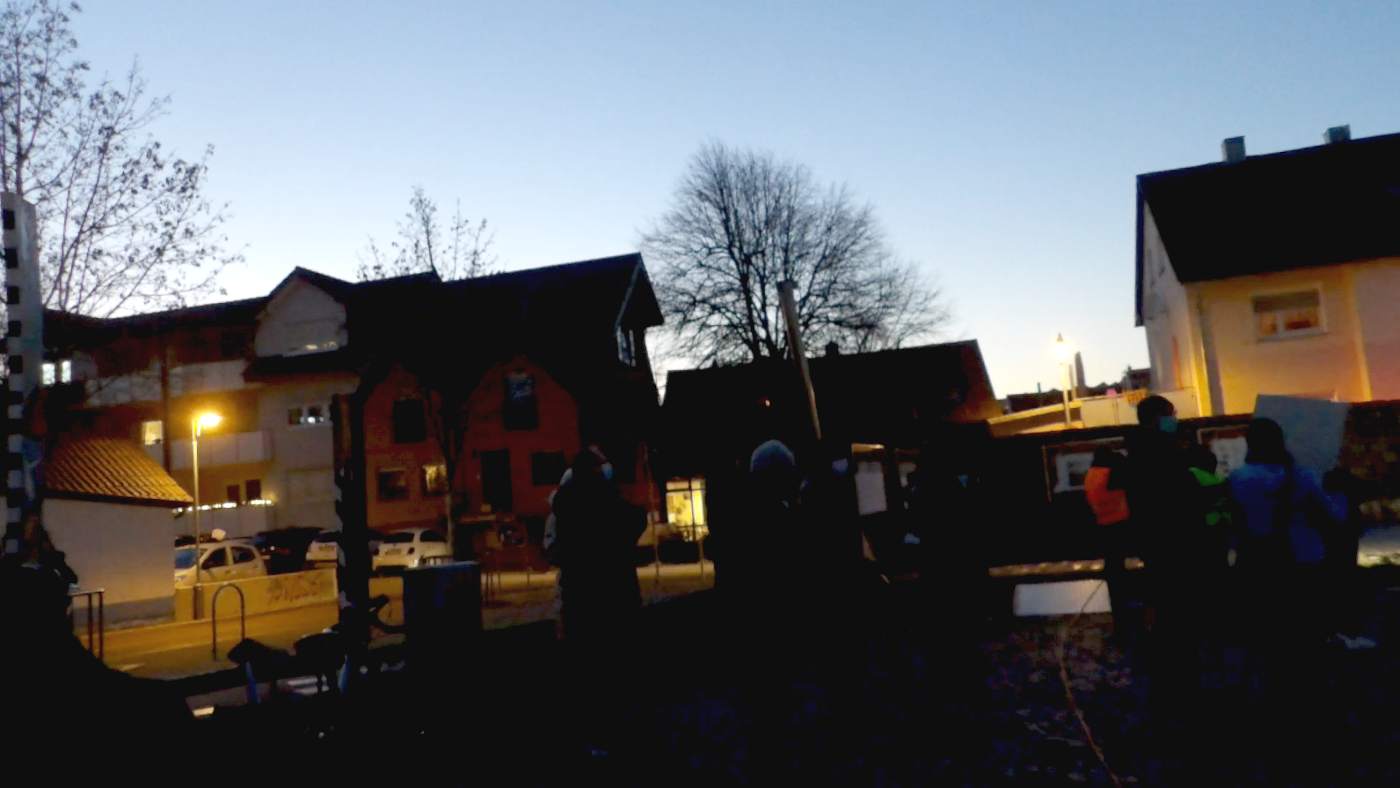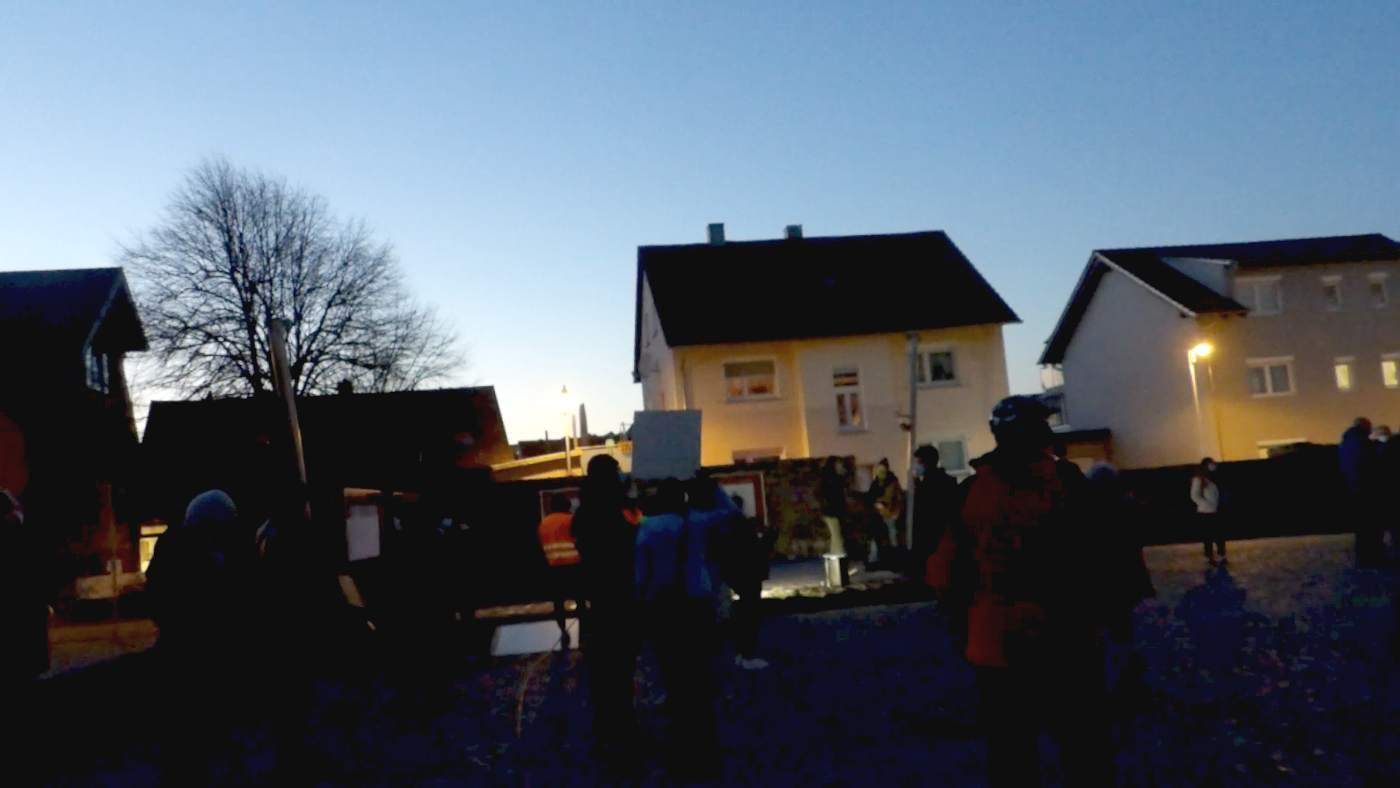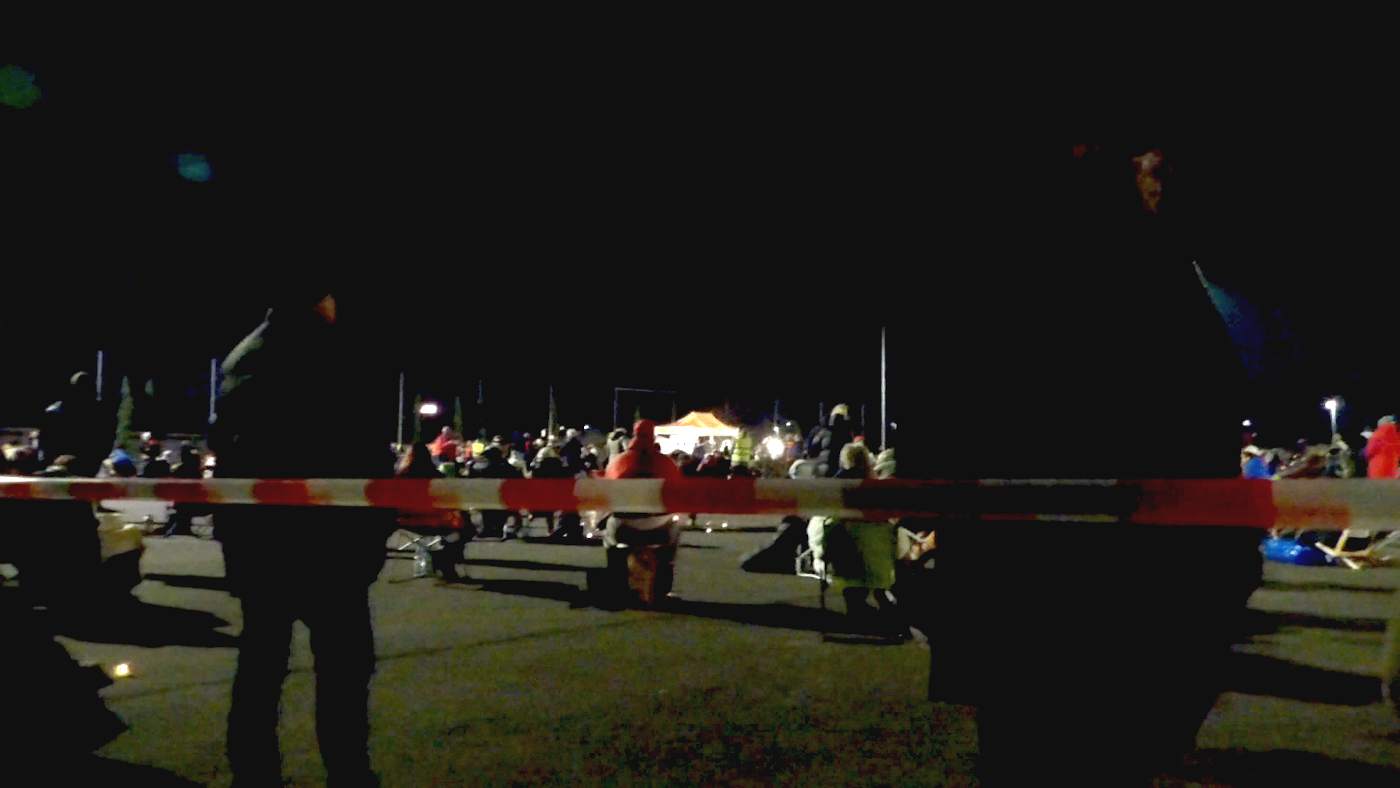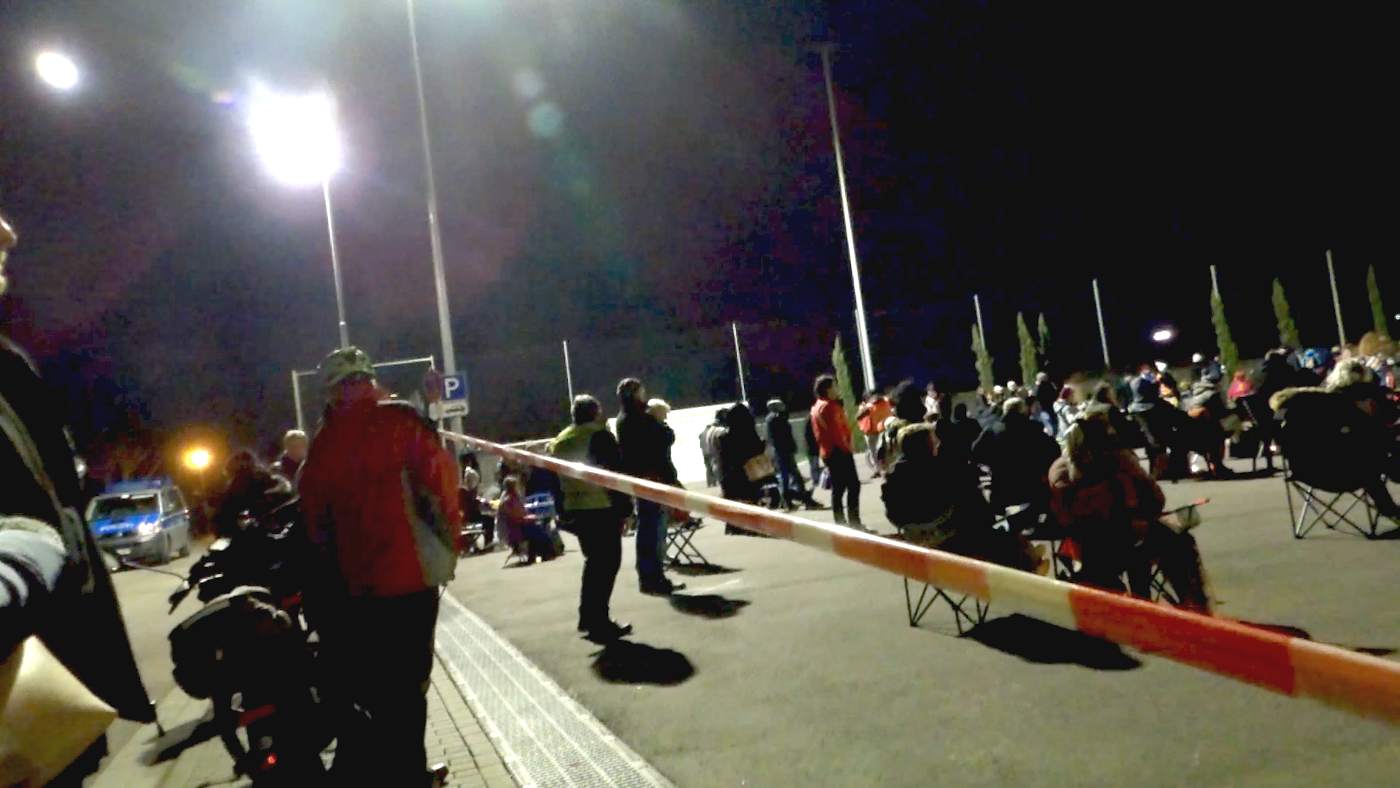Sinsheim: Corona demo on November 27, 2020
In Sinsheim we are still human
Difference between lateral thinking and antifa
In Kaiserslautern, the police chief had tinted in Gauleiter manner: "Now we'll put an end to the spook!" Therefore, I reckoned that in Sinsheim, too, no demonstration could be permitted. But in Sinsheim we are still allowed to be human beings at the moment. At the Burgplatz, some people stood in the dark and I was told that this is where the counter-demonstration of the Antifa took place. The lateral thinking demo would take place at the municipal swimming pool. It was very nice that this information was not kept from me.
CORONA-DIKTATUR-DEMO IN SINSHEIM AM SCHWIMMBAD
At the swimming pool I was surprised by a large crowd. Didn't Mrs. Merkel contribute a lot to the fact that so many critical people came together? Mrs. Merkel is now talking about a corona sideways movement, due to which the measures should be tightened. What a stupid excuse! Who wants to believe the most insincere of all Chancellors anymore?
Prospects
The Chancellor's use of power is becoming increasingly illogical. Anyone who exaggerates like Frau Merkel has no good intentions. It becomes more and more apparent that this woman does not want to give up power in the course of the decline of German culture and industry. A postponement of the elections to 2021 is already a rumor.
Three factors come together: Germans are very patient and Mrs. Merkel radiates pure boredom. The Bundestag consists of people who only have their million-dollar villas in view. These three simple facts are the fabric of doom.
The missing video for Covid 19 by Michael Yeadon, former VP of Pfizer
MICHAEL YEADON, FORMER VP OF PFIZER, ABOUT COVID 19
Transscript
My name is Dr Michael Yeadon.
My original training was a first-class honours degree in biochemistry and toxicology. Followed by a research-based PhD into respiratory pharmacology; and after that I've worked my entire life, uh, on the research side of the pharmaceutical industry – both big pharma and also biotech. My specific focus has been inflammation, immunology, allergy in the context of respiratory diseases (so the lung, but also the skin). So I would say I'm a kind of a deeply experienced inflammation, immunology, pulmonology kind of research person.
I initially became concerned about, the, our response to the coronavirus pandemic towards the middle or back end of April as early as that. It had become clear that if you look at the number of daily deaths versus the date the pandemic had turned. Really, pleasingly, already the wave was fundamentally over, and we would just watch it fall for a number of months – which is what it did. And so I became very perturbed about increasing restrictions on the behavior and movement of people in my country and I could see no reason for it then and I still don't.
Government's response to emergencies is guided by the scientific group who sit together under the Scientific Advisory Group for Emergencies or SAGE. So they should provide scientific advice to the government about what's appropriate to do. SAGE has got several things wrong, and that has led to advice that's inappropriate and – uh, not only has had horrible economic effects, but has had continuing medical effects in that people are no longer being treated properly.
SAGE took the view that since SARS-CoV-2 was a new virus that they believed there wouldn't be any immunity at all in the population. So, I think that's the first thing. I remember hearing that and I puzzled, because I already knew – because I read the scientific literature that SARS-CoV-2 was 80% similar to another virus you may have heard of called SARS that moved around the world a bit in 2003, and more than that: it's quite similar, in pieces of it, to common cold-causing coronaviruses.
So, when I heard that there was this coronavirus moving across the world I wasn't as worried as perhaps other people were, because I figured that since there are four common cold-causing coronaviruses, I figured that quite a lot of the population we've been exposed to one of those viruses, and would probably have a perhaps substantial protective immunity. And just to explain why I was so confident everybody knows the story of Edward Jenner and vaccination, and the story of cowpox and smallpox. And that the old story was that milkmaids had very, uh, clear complexions: they never suffered from things like smallpox, that if it didn't kill you would leave your skin permanently scarred. And the reason that they had the protection was that they were exposed to a more benign, related virus called cowpox.
Edward Jenner came up with the idea that if it's cowpox that saves the fair maid – he reasoned that if he could give another person an exposure to the cowpox, he would be able to protect them from smallpox. Now, he did an experiment that you can't do now – and he never should have done it – but apocryphally, or really, or maybe you're ill, we're not sure. Edward Jenner acquired some of the liquid from a person infected with cowpox. Relatively mild pustules that then go away. And he got some of this and he – he scraped it into the skin of a small boy and a few weeks later, he obtained some liquid from some poor person that was dying of smallpox and infected the boy. And, lo and behold, the boy did not get ill and that gave birth to the whole field of what's called vaccination. And vax, the vaccine's "vac." It comes from "vaccus," the Latin name for cow. So, we are really familiar with the principle of cross immunization.
I've thought quite a lot about, you know, the vulnerable people in in care homes and there's an awareness that, even though people really careful using PPE and so on, but that's only going to go so far in a kind of, hot house environment where people are pretty close together in a care home. So the question I've had all year is: once one or two people, you know, got the virus in a care home, why wouldn't almost everyone get infected? And of course the truth is, they didn't. And one interpretation of that distinction is that a large proportion of people in the care homes had prior immunity.
At this time of year, about 1 in 30 people have a cold, caused by one of these coronaviruses. And just like the protection against smallpox provided by previous exposure to cowpox, so people exposed to having had a cold caused by one of these coronaviruses they're now immune to SARS-CoV-2. So, 30% of the population was protected before the start. SAGE said it was zero – and I don't understand how they could possibly have justified that. There's a second, and equally fatal, unaccountable error that they have made in their model. The percentage of the population that SAGE asserts have been infected to date by the virus is about seven percent. I know that that's what they believe and you can see it in a document they published in September called "Non-pharmaceutical interventions" and it says sadly more than 90% of the population is still vulnerable.
It's unbelievably wrong. And I'm just going to explain why: they've based their number on the percentage of people in the country who have antibodies in their blood. And only the people who became most ill needed to actually develop and release antibodies around their body. So, it is certainly true that the people who have lots of antibodies were infected. But a very large number of people had milder symptoms, and even more people had none at all. And the best estimates that we can arrive at is that those people either made no antibodies, or so low amounts that they will have faded from now.
A recent publication on the percentage of care home residents who have antibodies to the virus very, very interesting. This time they were using high sensitivity tests for antibodies and they carefully picked out residents that never were PCR-positive: these are people who never got infected. And they found that 65% of them had antibodies to the virus; they never got infected. So I believe there was high prevalence of immunity in that population prior to the virus arriving. Big story in the media, recently, was that the percentage of people with antibodies against the virus in their blood was falling. Now, this was cast as a concern that immunity to SARS-CoV-2 doesn't last very long. Well, you know, anyone with knowledge of immunity would – would just simply reject that. It's not the way immunity to virus works – that would be T-cells. So, if the antibodies are falling gradually over time – which they have – from spring to present, the only plausible explanation is that the prevalence of the virus in the population is falling, and that's why the antibody production gradually subsides.
Less than 40% of the population are susceptible. Even theoretical epidemiologists would tell you that that's too small a number to support a consolidated and growing outbreak, community immunity, herd immunity. So, SAGE says that we're not even close, and I'm telling you that the best science, by the best scientists in the world, published in the top peer-reviewed journals, says they're wrong: that more than 60 of the population are now immune, and it's simply not possible to have a large and growing pandemic.
Really good news, genuine good news, to hear that there's data emerging from the vaccine clinical trials, and we are seeing vaccines that raise not just antibodies – but they're also producing T-cell responses. This is great; back to proper science, proper immunology. That's how immunity to viruses works. So, my surprise though, and it's just annoying that when we're talking about, uh, the percentage of the population that's still susceptible we only talk about antibodies, like seven percent from SAGE. Why are we not talking about the 50% that have got T-cell immunity?
And so you might be thinking if Mike – and Dr Mike Yeadon is telling you these things… – or how come the pandemic isn't over? Well, this may come as a surprise to you, but I believe fundamentally it is over. The country has experienced almost a complete cycle now of the virus sweeping through the land, and we are at the end of it. London was -was horribly affected in the spring, and somewhere in early April they were experiencing several hundred deaths per day from people dying with similar symptoms in respiratory failure and, uh, inflammation. And at the moment the number of people dying of SARS-CoV-2 in the capital is less than 10. So it's down by 98, or something like that. And, the reason it's down, is because there are now too few people in London susceptible to allow the virus to magnify, to amplify, to get an epidemic. And, and they would have been hit by now, because they were the first place hit in the spring. And I think what we're seeing now in the Northeast and the Northwest would be the dying embers of the spreading out of this virus. And I'm very sorry that it is still true, that a small number of people are catching it, getting ill, and dying.
So why aren't the media telling us that the pandemic is over? It's not over because SAGE says it's not. So SAGE consists of very many scientists, from a range of disciplines – mathematicians and clinicians – and there are multiple committees. But I found to my surprise – and I'm actually going to use the word – horror, that in the spring, all the way through the spring and summer, SAGE did not have on their committee someone who I would call a card-carrying immunologist; a clinical immunologist. I have to say I think that in the spring and summer SAGE was deficient in the expertise it had. They should have armed themselves, you know, with – around the table all the people required to to understand what was happening, and they didn't do that. People asked me then, "Well Mike, if it's, you know, if it's fundamentally over, why are we still getting hundreds of deaths a day from SARS-CoV-2?" And I've thought a lot about this. There is a test that's performed where people have their noses and tonsils swabbed, and then a test (called a PCR test) is performed on that. And what they're looking for isn't the virus – you might think it's looking for the virus, but it's not. What they're looking for is a small piece of genetic sequence; it's called RNA. Unfortunately, that bit of RNA will be found in people's tonsils and nose not if they've just caught the virus, and they're about to get ill, or they're already ill. It's also going to be found if they were infected previously weeks – or even, sometimes, a small number of months ago. Let me just explain why that is.
If you've been infected, and you've fought off the virus (which most people do), you'll have broken, dead bits of virus. These are tiny things smaller than your cells, perhaps spread all the way through your airway, embedded in bits of mucus, maybe inside an airway lining cell. And so over a period of weeks or months you bring up cells that contain broken, dead pieces of the virus that you have conquered and killed. However, the PCR test is not able to detect whether the viral RNA has come from a living virus or a dead one (as I've just described). So I think a large proportion of the so-called positives are, in fact, what I call "cold" positives: they're correctly identifying that there is some viral RNA in the sample – but it's from a dead virus. It can't hurt them, they're not going to get ill, they can't transmit it to anybody else. So they're not infectious. So that accounts for a large number of the so-called positive cases. These are people who've beaten the virus. Why are we using this test that cannot distinguish between active infection and people who've conquered the virus?
This test has never been used in this way – and I've worked in this field. It's not a suitable technique it's a – it's the kind of technique you would use for forensic purposes, if you were trying to do a DNA test to establish whether or not a person was at the scene of a crime. You would not be doing these tests by a windy, supermarket car parking; what looks like plastic marquee tents; on picnic tables. It's not suitable at all – and it definitely shouldn't be done in the way it's been done. It's subject to many mechanical errors, should we say, handling errors. If this was a test being used for legal purposes, for forensic purposes like a DNA identity test, the judge would throw out this evidence; would say it's not admissible. It produces positives even when there's no virus there at all. We call that a false positive.
As we've increased the number of tests done per day, so we've had to recruit less and less experienced laboratory staff – and now we're using people who've never worked professionally in this area. What that does is it increases the frequency of mistakes, and the effect of this is that the false positive rate rises and rises. So, if you had a false positive rate of one percent – which Mr. Matt Hancock [British Secretary of State for Health and Social Care] told us was roughly the number they had in the summer – then if you tested a thousand people that had no virus ten of them would be positive, astonishingly. If the prevalence of the virus was only one in a thousand, that's 0.1% – as the Office for National Statistics told us it was through the summer – then if you use the PCR test only one of them will be positive and genuinely so. But if the false positive rate is as low as one percent, you'll also get 10 positives that are false.
Some people did say to me, "Well, there'll be a higher percentage of people coming forward for testing in the community," so-called "Pillar 2" testing, because they've been instructed only to come if they've got symptoms. But I call B.S. on that one. I don't think that's true. I know lots of friends and relatives who've been told by an employer, "Well, you've sat near someone who's tested positive, and I don't want you to come back to work until you've got a negative test." I've seen information from many towns in the North – certainly Birmingham was one; Manchester was another; Bolton – where councils (and I really think they were trying to be helpful) were out leafleting the people of their cities saying, "We're going to come round and swab you all because we want to track down this virus." Now once you start testing people, more or less randomly, instead of [those] having symptoms you get the same amount of virus in the population as the Office of National Statistics found which is, at the time was, one in a thousand. And I've just told you Matt Hancock confirmed during the summer they had a false positive rate of about one percent. So that means out of a thousand people 10 would test positive, and it would be a false result, and only one would test positive and it was correct.
This test is monstrously unsuitable for detecting who has live virus in their airway. It's subject to multiple distortions that are worsening as we get into the winter. As the number of tests done per day increase[s], the number of errors made by these overworked, not very experienced lab staff increase[s]. I think it's not unreasonable to say a best guess of the false positive rate at the moment – what's called the operational false positive rate is about five percent. Five percent of 300,000 is 15,000 positives. I think some of those positives are real; I don't think it's very many. Now, the problem with this false positive issue [is] it doesn't just stop it at "cases": it extends to people who are unwell and go to hospital. So people who go to hospital having tested positive – and it could be a false positive, and I think most of them are at the moment – if you go to hospital and you've tested positive previously, or you test positive in hospital, you'll be counted now as a Covid admission.
Although there are more people in hospital now than a month ago, this is normal for autumn. Regrettably, people catch respiratory viruses and become ill, and some will die. I just don't believe it's got anything to do with Covid-19 anymore. There are more people in intensive care beds now than there were a month or so ago. That's entirely normal as we move through late autumn into the early winter: those beds become used. But there aren't more people than is normal for the time of year, and we're not about to run out of capacity, certainly at a national level. But I think you know it is going now: if you should now die, you'll be counted as a Covid death. But that's not correct; these are people who might have – have gone to hospital having had a broken leg, for example, but they'll – three percent of them will still test positive, and they're not, they haven't got the virus. It's a – it's a false positive, and if they die they'll be called a Covid death – and they are not. They've died of something else.
One of the most troubling things I've heard this year was Mr. Johnson telling us about the "Moonshot" testing everybody often, maybe every day, is the way out of this problem. I'm telling you it's the way to keep us in this problem: that number of tests is orders of magnitude higher than we're already testing now, and the false positive rate (however low it is) will be far too large to accept. It will produce an enormous number of false positives.
What we should do is stop mass testing. Not only is it an affront to your liberty, it will not help at all: it will be immensely expensive and it will be a pathology all of its own. We'll be fighting off stupid people – mostly government ministers – I'm sorry to say, who are not numerate, and do not understand statistics. If you test a million people a day with a test that produces one percent false positives, 10 000 people a day will wrongly be told they've got the virus. If the prevalence of the virus was say 0.1%, like the Office of National Statistics said it was in summer, then only a tenth of that number, uh, 1,000 would correctly be identified. But you can't distinguish amongst the 11,000 who have genuinely got the virus and who are false positives. Moonshot, I think, will have a worse false positive rate. It's not fixable, and it's not necessary either. The pandemic – having passed through the population not only of, of the UK, but of all of Europe – and probably all of the world quite soon – it won't return. Why won't it return? Well, they've got T-cell immunity. We know this. It's been studied by the best cellular immunologists in the world.
Sometimes people will say, "Well, it looks like the immunity is starting to fade." You'll sometimes see [statements] like that, and when I saw the first headline like this I remember being really quite confused, because that's not the way immunology works. Just think about it for a moment. If that was how it worked it could kill you. When you had to fight it off, and if you had successfully done that, it somehow didn't leave a mark in your body. Well, it does leave a mark on your body. The way you fought it off involved certain pattern recognition receptors, and has left you with – as it were – memory cells that remember what it was they fought off. And if they see that thing again it's very easy for them to get those cells to work again in minutes or hours, and they will protect you. So the most likely explanation is it'll last a long time.
So I read a bit more about this so-called tailing off of immunity – and I realized they were talking about antibodies. Just incorrect to – to think that antibodies, and how long they stay up, is a measure of immune protection against viruses. I mean you can tell I'm – I don't agree with this. It says there have been some classic experiments done on people who have inborn errors in parts of their immune system, and some of them have inborn arrows that means they can't make antibodies, and guess what: they – they are able to handle respiratory viruses the same as you and me. So, I don't think it's harmful to have antibodies, although some people are worried about the potential for amplifying inflammation from antibodies, but – but my view is that they're – they're probably neutral, and you definitely should not believe the story that because the antibody falls away you've lost immunity. Again, that's just not the way the human immune system works.
The most likely duration of immunity to a respiratory virus like SARS-CoV-2 is multiple years. Why do I say that? We actually have the data for a virus that swept through parts of the world 17 years ago called SARS, and remember SARS-CoV-2 is 80% similar to SARS, so I think that's the best comparison that anyone can provide. The evidence is clear. These very clever cellular immunologists studied all the people they could get hold of who had survived SARS 17 years ago. They took a blood sample, and they tested whether they responded or not to the original SARS, and they all did. They all have perfectly normal, robust T-cell memory. They are actually also protected against SARS-CoV-2 because it's so similar, it's cross-immunity. So, I would say the best data that exists is that immunity should be robust for at least 17 years. I think it's entirely possible that it is lifelong. The style of the responses of these people's T-cells were the same as if you've been vaccinated and then you come back years later to see, has that immunity been retained? And so I think the evidence is really strong that the duration of immunity will be multiple years, and possibly lifelong.
There have been but a tiny handful of people who appear to have been infected twice – now they're very interesting, we need to know who they are and understand them very well, they've probably got certain rare immune deficiency syndromes. So I'm not pretending no one ever gets reinfected, but I am pointing out that it's literally five people (or maybe 50 people), but the World Health Organization estimated some weeks ago that 750 million people have been infected so far by SARS-CoV-2. That means most people are not being reinfected, and I can tell you why that is: it's normal. It's what happens with viruses, respiratory viruses. Some people have – have called for "zero Covid" as if it's some political slogan. And there are some people I've heard calling for it almost every day; they're completely unqualified to tell you anything.
Something that's really important to know is that SARS-CoV-2 – it's an unpleasant virus. There's no question about it, but it's not what you were told in spring. We were originally told that it would kill perhaps three percent of people it infected – which is horrifying. That's 30 times worse than flu. We always overestimate the lethality of new infectious diseases when we're in the eye of the storm. I believe the true infection fatality ratio of Covid-19, the true threat to life is, the same as seasonal flu.
So there's no reason why you would want to try and drive Covid to zero. It's a nonsense – that's just not how biology is. And all the means I have heard, uh, proposed, as ways to get us there are much more damaging and pathological, I would say, than than the virus itself. It's simply not possible to get rid of every single copy of the Covid-19 virus, and the means to get you there would destroy society. Forget the cost – although it would be huge – it would destroy your liberty, you would need to not go out until you've been tested and have your result back. And I have described how the false positive rate would just destroy it from a statistical perspective. I don't believe it can be done: it's not scientifically realistic, it's not medically realistic, and it's not what we have ever done.
As the virus swept towards the UK in the – in the late winter and early spring I too was concerned, because at the time we were told perhaps three percent might die. So when the Prime Minister called for a lockdown I wasn't pleased about it, but I understood that we should try this. But it's important that you understand, that when we look at the profile of the pandemic as it passed through the population, that it was clear that the number of infections every day was falling. We'd passed the peak quite a long time before lockdown started. So we took all that pain, that locked down pain which was multiple weeks – I don't remember exactly how many multiple weeks – we took it for nothing. If there was a really important effect of lockdown on the number of people who died, or the rate of it, you should at least be able to order them. Like, these people had locked down, and these didn't – and you cannot. All heavily infected countries' shapes are the same, whether they had locked down or not. They don't work. I don't know why anyone is allowing you, know you, to be pushed into this corner.
I don't think we entirely know why it is that some countries were hit harder than others, but I have to say I think scientifically the smart money is on a mixture of forces. One would be this cross immunity. Although China had an awful time in Wuhan, in Hubei province, it didn't spread elsewhere in the country, and I suspect that meant because a lot of them had this cross immunity. And I think nearby countries, in the main, had lots of cross immunity. So that's one possibility. The other one, though, is in terms of the severity of what did the virus do to a particular population. We've seen devastating effects in countries like UK and in Belgium, uh, France, and maybe even in Sweden, and much smaller numbers of deaths in other countries like – like Greece and in Germany. And you might think, "Well, was that was it something that they did?" And I wish it was true, because if it was something we did we could learn from it and do it and it would work in the future. But there's no evidence whatsoever that it was anything humans did. The passage of this virus through the human population is an entirely natural process that completely ignored our puny efforts to control it.
So there is this theory – I don't like the name very much – but it's called "dry tinder." If people in a country who are vulnerable for to dying in the winter (usually of respiratory viruses), if you have a very mild winter season, like UK did – we had a very mild seasonal flu last year and the year before and so did Sweden – then what happens is there are larger number of very vulnerable people who are even older than usual, and – and I think that's why we suffered a rather large number of deaths. It was still only 0.06% of the population, equivalent to about four weeks of normal mortality. But countries that had very severe winters recently, and Greece and Germany certainly had very lethal winter flus in the last two years. I think then, they had a smaller population of very vulnerable people, and that is the main reason why they lost fewer people. It's not to do with locking down, it's not to do with testing, or tracking, or tracing. I personally don't think any of those measures have made any difference at all. So Belgium and UK and Sweden were particularly vulnerable, whereas adjacent Nordic countries – I – I get fed up with hearing about this, uh, idea that they locked down and that's why it saved them and afraid the other Nordic countries had normal flu epidemics the last two or three years. Sweden, like UK, had very mild epidemics: you can just go and look at the number of deaths, it's sub-normal for UK and Sweden. And now we've got a supra-normal, a larger-than-normal, number of deaths from Covid.
Now there may be other reasons, I'm not saying there are not but I think those two main forces – the amount of prior immunity and the so-called "dry tinder," what vulnerable fraction of the population did you have as a result of seasonal flu being intense or not – I think that accounts for most of it. And it's – it's just puberistic and, uh, and – and kind of silly that our government and advisors tell you that doing things that have never worked in the past, like lockdown are going to make any difference to the transfer of respiratory viruses. I don't believe it for a moment. There's no scientific evidence behind it and there are much stronger scientific hypotheses that do explain it. You might think that in terms of numbers of deaths – excess deaths – that Covid has produced such a large number that this will be an awful year for excess deaths, but surprisingly not. 2020 is lining up to be about eighth in a list since 1993.
Roughly 620,000 people die every year in this country. They say in life we are also in death – and it's true, it's been awful for those who have been personally affected by illness and death, but it's not particularly unusual in terms of the number of people who've died. So one of the things I've noticed has happened in – in recent years is that we almost seem to be moving, uh, you know post-science, post-fact as if – as if facts don't matter. For someone who's qualified and practiced as a professional scientist for 35 years I think it's deeply distressing that, I don't think you should listen to me if I talked about – I don't know, the design of motorways or something – like, I don't know anything about motorways or – or how to grow trees better, I don't know anything about that. But I do know quite a lot about immunology, infection, inflammation, and the way infectious organisms move through a population.
I've no other reason for giving this interview other than I really care what happens to my country – and we have to pull ourselves out of this. And I personally believe the way forward is twofold, it's not difficult. One, we should cease mass testing of the mostly-well in the community immediately – it only provides misleading and grey information, and yet we're driving policy almost completely based on it. It's definitely wrong, we should not do it. Use the tests in hospital – I'm not saying don't test – don't continue mass testing, and for God's sake, don't increase the number of tests. It is a pathology all of its own which must be stamped out by right thinking people. And I'm afraid the people on SAGE, who have provided the modeling, the predictions, the – the measures that should be taken, that their work is so badly, and obviously flawed – lethally incompetent, that you should have no more to do with these people. They should be fired immediately. And the effect of that advice has been to – have cost lots of innocent people their lives from non-Covid causes, they should be dismissed and reconstituted using an appropriate group of skilled individuals – especially avoiding any who might even have the suggestion of a conflict of interest. I think we're right at the edge of the precipice. I really hope that we can pull back.












